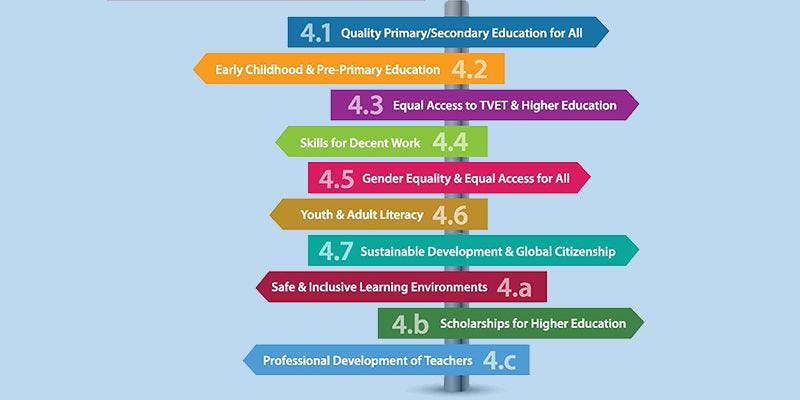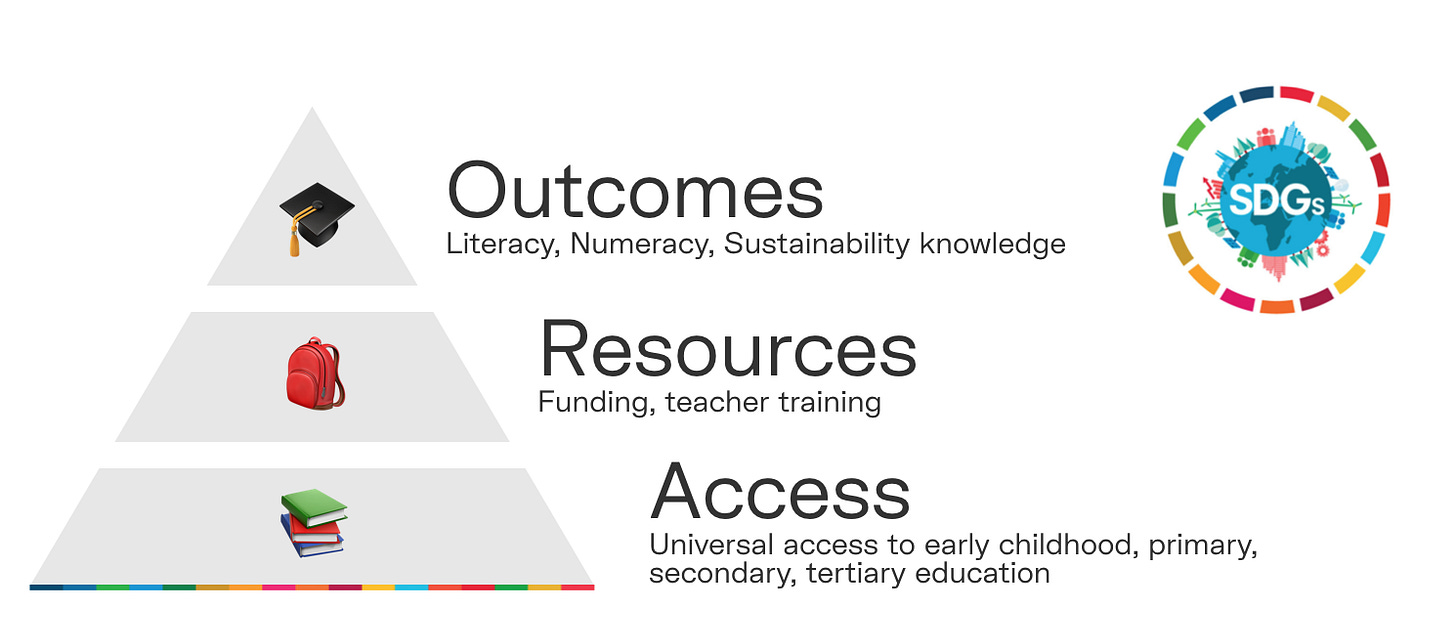Education for All 🎒Transcend Newsletter #42
COVID disrupted education – but in all the wrong ways. S21 Transcend Fellowship!
Hey! Alberto here. Welcome to the Transcend Newsletter.
The Transcend Newsletter explores the intersection of the future of education and the future work, and the founders building it around the world.
We welcome 78 new readers since our last newsletter! If you have other friends who’d find this analysis intriguing, hit the ❤️ button and share the Transcend Newsletter with them!
🚨We also have exciting news! We are taking applications for our Summer 2021 Transcend Fellowship until this Friday, May 28th! We will be selecting a cohort of 25 early-stage founders to join our program and founder community of 80+ founders from 24 countries! If you want to get a feel for what the Fellowship will be like or ask any questions about it, join our live session tomorrow!
Education for All 🎒
A year ago, I wrote about the Sustainable Development Goals (SDGs) in a piece called The Greatest Shock: the ambitious global plan led by the United Nations to address the world's largest challenges by 2030. 193 nations ratified it and committed over $2.5T in funding to be deployed for the next fifteen years.
But COVID threw a wrench in the work, and the once historical goals were in big trouble – when we published The Greatest Shock, 94% of the global student population had been affected by school closures.
Today I'm revisiting the progress on the SDGs one year later, and taking a step back to ask: are we on track to bring education to all?
The Sustainable Development Goals
The SDGs range from poverty alleviation to equal rights for women and minorities or peace. Education is at the core of this plan, and is represented by SDG #4: Inclusive and Equitable Quality Education For All.
SDG 4: Ensure inclusive and equitable quality education and promote lifelong learning opportunities for all
The SDG 4 is an ambitious one. It sets out to achieve global access to schooling from early childhood (0-3) to higher education and lifelong learning (18+) while addressing the existing inequalities between countries and individuals.
It has 10 subgoals (each with at least one indicator associated to measure progress). I see these goals grouped into three categories:
Access goals: universal access to early childhood, primary, secondary education, higher education and vocational education for those who want it. Even entrepreneurship education. All while eliminating gender, racial and accessibility barriers.
Resource goals: financial support (funding, scholarships) for students in countries who most need it, and for teachers through formal training.
Learning outcomes goals: literacy and numeracy knowledge from students in education systems, and also awareness of sustainability.
In 2015, there was strong momentum to accomplish these audacious goals. Six years into the journey, a lot has changed: these nations are now facing by far the greatest challenge to development progress in recent history.
Are we on track?
The SDGs provide a common benchmark for progress, and that's a great thing. Nations have common indicators and data (though often lacking in low-income countries) to draw conclusions and make decisions.
That data can be overwhelming at times, so let's imagine a simple scenario: a conversation between an optimistic UN bureaucrat, and a critic of the progress made so far.
The optimist would likely argue for two things. First, there has been steady progress in primary school enrollment (for ~4-11-year-olds) in the last decade, from 65% of kids enrolled in 2010 to 73% in 2019. Here we have achieved gender parity, so there are no differences in female enrollment.
Secondly, the optimist would likely point to the growth in aid for education. In the last decade, there has been a 21% increase in aid allocated to education, reaching $16B. International aid for scholarships represents almost $2B a year now (up 35% since 2017).
The optimist would look at all the charts in Our World in Data and say, "Up and to the right, that's not too bad after all!".
The pessimist would have a lot to push back on.
While primary school enrollment has grown massively, the numbers in secondary schooling don't match it. Over 200 million children are projected to be out of school by 2030, and there are gender gaps at this level of education in most countries.
Secondly, while aid has grown, the total funding for education has not. In fact, there is a growing funding gap to finance education globally that reached $140B in 2019 and ballooned to $200B with the pandemic.
Other indicators that were going well have stalled. For example, primary school teacher training has stagnated around 85% since 2015, staying in the mid 60%s in Sub-Saharan Africa.
Worst of all, COVID has massively disrupted education – but in all the wrong ways.
The pessimist would likely win this debate, unfortunately. The results were not encouraging heading into 2020, and this year (which the UN declared a "generational catastrophe" for education) has wiped out decades of steady progress.
Revisiting "The Greatest Shock"
As the world slowly gets vaccinated, the effect of the pandemic remains. In The Greatest Shock, we talked about the key effects of COVID in education: school closures and the learning loss for students.
Are they still a problem? The answer is a clear yes.
School closures: One year into the COVID-19 crisis which kept 1.6B students away from school, 2 in 3 students worldwide are still affected by full or partial school closures.
Learning loss: school closures affected students' performance, so much so that over 100M students (from grades 1 to 9) fell below the minimum reading proficiency levels in 2020.
Recovery to pre-COVID levels could come around 2024, but only if countries commit to remedial and catchup strategies. The SDGs gave us an ambitious benchmark. Six years into this journey, it's fair to say we have not risen to the challenge.
What can we do better?
There's a lot of work to do. Here are some of the strongest proposals for the education community to address the time lost in 2020:
💵 Increase education aid to low-income countries – 65% of the world's poorest countries have been forced to lower their investment in education, doubling that of middle and high-income nations. This leaves students exposed, as the poorest households have to personally pay for their education at a much higher rate than in high-income countries. Private donors tend to prefer investing in education in middle-income countries where the risks are lower, but low-income countries need it most to bridge the funding gap (they receive less than half of all aid!)
📐 Extend impact measurement and reporting practices – the main value of the SDGs to me is that it gives us a common North Star for where work needs to happen in the 2020s. But not enough stakeholders are using it to inform their work. They should be used at length alongside other existing Impact measurement frameworks to make sure we move our resources as societies to where they are needed!
📲 Scale text-first and phone first-learning tools (mostly offline!) – 2020 was all about Zoom for most students I know in school, but less than 50% of students in middle or low-income countries got to experience remote learning at all. That's because 700M students do not have access to the internet, so we need new media to reach them such as text-based or offline materials, like Foondamate, Mosabi, Kolibri, or Arist.
🎓 Remedial programs for students: remedial and re-enrolment programs could reduce the funding gap by 75% and put the world back on track to recover by 2024. Large-scale tutoring, curriculum changes to adapt to the students' new needs, new assessments and programs for dropout students, etc.
The bottom line.
Silicon Valley's eternal techno-optimism needs a dose of reality every once in a while, and the SDGs in 2021 are a full cup of it.
I personally try to stay optimistic about the state and future of education, despite these issues. Even in a topic as difficult as this one, I believe we have an opportunity to use technology and existing startup funding to address these large-scale problems. It will require a lot of work, but we have a decade to make it happen.
We are always on the lookout for great startup founders building the future of learning and work at Transcend Network. Reply to this email and let’s chat if that’s you!
news roundup around the future of learning and work
📮 While remote learning proved difficult for students in early 2020, student perceptions have improved as students and parents don’t want it to leave fully.
🚀 We keep updating and improving our list of Minervans looking for opportunities (students and graduates) – some of the most talented youth in the world who graduates today!
🙌 Vriti Saraf, founder of K20 educators and F20 Transcend Fellow, is organizing the first Twitter Spaces conference about education on June 4-5th and will be joined by amazing speakers like Sal Khan or Tony Wagner.
🗺 Meet the Elite 200 founders at the GSV Cup who’ll participate in the award, and take a peek at the six Transcend Fellows joining this year!
exciting job opportunities we want to share with you!
Placements Lead – Stoa School
Research Lead, Product Development – Section4
Content Writer, AP courses – Everydae
For more job opportunities, check out our full Job Board!.
Did you enjoy reading this piece?
Hit the ❤️ button to help us reach more awesome people like you!










An important viewpoint, particularly with regard to 'techno-optimism' (am bringing all of this into critical review for a CPD programme I am currently developing for The Commonwealth of Learning, Vancouver.) Thank you.
Alberto, I would love to hear your take on how covid affected goal 8 on decent work for all. in my opinion, more practically important than years of schooling.